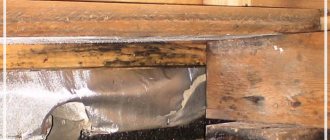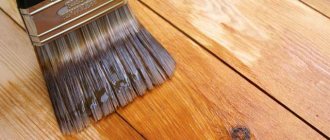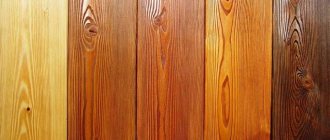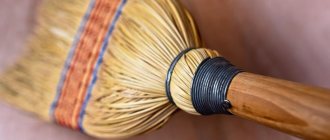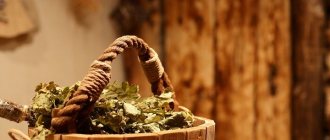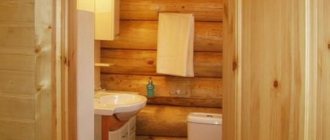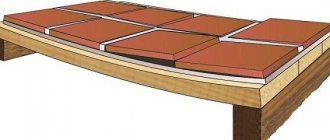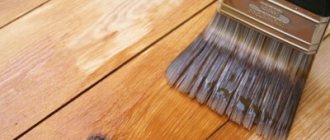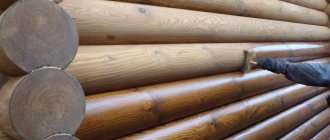Joists are important structural elements of a home that serve as support for the subfloor and flooring. The joists provide rigidity and strength to the entire floor structure. Therefore, it is very important to ensure their long-term operation, protecting them from rotting and insects. From the article you will learn how to treat floor joists in a wooden house, and we will also focus on means for treating other internal elements of a log house. Not only the external walls of a wooden building are exposed to adverse effects, but also inside the house the wood requires good protection from moisture and insects. The criteria for selecting drugs for internal processing are described below.
Why do logs rot in bathhouses?
The wooden floor in the bathhouse is pleasant underfoot, retains heat well, looks and smells nice. But the conditions for boards in this building are harsh. High temperature and humidity create conditions for harmful processes - rotting and fungal growth. Rotting is visible on the floor boards, but if the pathological process has affected the joists, the problem will not become noticeable soon.
Causes of log rotting:
- Gaps in the floor through which water penetrates under the boards;
- Poor ventilation, lack of windows;
- The oven is of insufficient size and does not provide the required temperature;
- Improper drainage around the building;
- Presence of rotting areas on floor boards.
If the owner does not carefully monitor the wooden floor in the bathhouse, rotting can destroy the structure in 2-3 years.
Signs of rotting logs:
- Crackling and creaking of the floor with intact boards;
- Mobility of boards for no apparent reason;
- The smell of rot and mold that remains even after cleaning.
Rotten joists do not support the floor Source ytimg.com
Rotting beams release harmful substances into the air, this process intensifies at high temperatures.
Entering such a bathhouse does not make a person healthier, but harms the respiratory system and skin. If the process has gone too far, the joists may break under the weight of people at the most inopportune moment.
Protecting modern wood floors
Parquet boards and laminate already have a protective layer on the front side. Manufacturers also provide waterproofing on the bottom side, but the end sides of these materials, as a rule, are less protected (the only exceptions are materials whose locking devices have a silicone coating). Therefore, in order to protect the floor covering, a waterproofing material based on polyethylene film must be laid between it and the base. Such insulation must be monolithic. If it is laid in several strips, overlap and additional sealing with tape is provided.
It is necessary to lay the film (at least 50 microns thick) so that its edges extend at least 100 mm onto the walls. Excess material is carefully trimmed after installing the plinth.
For waterproofing a wooden floor, ordinary roofing felt or special adhesive moisture insulation is suitable.
What helps against rotting
Rot, like any disease, is easier to prevent than to treat. You need to take preventive measures when laying the floor - immediately treat the beams and boards with a protective compound. When choosing how to treat logs under the floor in a bathhouse, you need to pay attention to the type of substance (impregnation in a bathhouse is more reliable than a film-forming composition) and its interaction with water (the substance should not be washed out).
Industrial impregnation
This technique is used in factories. Wooden products are impregnated with protective substances at high temperature and under pressure. Industrial impregnation protects against rotting, fungi and bacteria. There are fire-fighting compounds and rodent repellents. The main advantage is that industrial impregnation penetrates to the maximum possible depth. The disadvantage is that such logs are more expensive than untreated ones.
Industrial processing solves many problems Source archispace.com
See also: Catalog of companies that specialize in paints and varnishes and related work
Antiseptic impregnations
To save money, you can buy untreated timber and impregnate them with a protective compound yourself. If you properly organize ventilation and drainage in the bathhouse, then such logs can be laid on any base, including earthen ones. Antiseptics for self-treatment are inferior to industrial ones in terms of penetration depth, but if the logs were not initially affected by rot, this does not matter.
Most often in stores you can find impregnations and “Neomid”. When choosing, you need to look at the labeling - the important ones are “for baths and saunas.” They mean that the substance does not contain volatile toxic compounds and is stable at high humidity and temperature.
Operating rules:
- Impregnation is carried out after laying the lags, so as not to disturb the protective layer during fastening;
- You need to work at temperatures from +10⁰ to +50⁰, having previously ventilated the room;
- For application use a brush, roller or spray;
- The impregnation is applied evenly, then allowed to dry for an hour;
Impregnation must be applied evenly Source folksland.net
- The procedure is repeated three times - this creates the most reliable protection against moisture.
After the last layer has dried, you need to additionally coat the logs with varnish, this will protect the impregnation from washing out. The same algorithm works for floor boards. No additional protective equipment is required.
The most thorough treatment is carried out in the washing room - this is the wettest place in the bath. It is not necessary to use varnish in the steam room, but it is important that the impregnation is resistant to temperature. In other rooms, you can limit yourself to a universal mixture for interior work.
The advantages of this treatment are that the owner himself selects the intensity of impregnation and does not overpay for excess substance where it is not needed. Bioprotective agents protect not only from rotting, but also from mold and bacteria. There are also fire-bioprotective agents that will protect the bathhouse from all types of harmful influences.
Disadvantages: time and labor costs. If the treatment was carried out before installing the logs, there is a risk of damaging the protective layer. If you carry it out after installation, the lower parts of the beams will remain untreated. This is not critical on a concrete or pre-treated wood base, but is risky if the base is earthen.
Folk remedies
Wooden floor joists can be treated not only with factory-made compounds, but also with all kinds of folk remedies.
- Transformer oil. When treating logs with this chemical, the oil penetrates deeply into the wood structure and embalms it. There is no scientifically proven evidence of the effectiveness of the method, but judging by the reviews of craftsmen, transformer oil really helps protect wood.
- Engine oil. Often used to protect logs and used motor oil. There is a significant drawback to its use - the waste has a very unpleasant and persistent odor. Moreover, the smell can persist for many years - until it completely disappears. Therefore, mining cannot be used everywhere: in technical premises, but not in residential buildings. The advantage of this technique is the low cost or even free use of used oil.
- Resin. Resin-based compositions, for example, coniferous resin or birch tar, protect wood well from rot, fungus, and pests. The main disadvantage of resinous compositions is their vulnerability to fire hazards. In addition, the resins have a persistent odor that is difficult to weather.
- Brine. According to some craftsmen, salt can protect wooden logs. To make the solution you will need 100 grams of salt per liter of water.
When choosing a specific composition for protecting lags, you should be guided by your goals. Of all the options described above, the ideal choice is a fire-retardant substance that has the maximum spectrum of action.
How to deal with rot
If the treatment turned out to be insufficient and the joists begin to rot, you can deal with the problem without completely replacing the floor. You need to start the fight against rot with thorough ventilation. Then you need to remove the floor boards, inspect the joists and find all areas of rot. Each affected area must be treated with one of the following compounds:
- Industrial products against rot and mold or other chlorine-based substances. They are used according to the instructions.
- A solution of a mixture of iron sulfate, potassium alum and table salt . Apply to the affected area with a brush. Completely destroys bacteria and fungi. The treatment must be repeated after a month for maximum results.
- Setting fire to sulfur . In the bathhouse, you need to tightly close the windows and ventilation, and exclude access to pets. Sulfur powder is poured into an iron can, set on fire and quickly left the room. Close the door tightly behind you and leave it overnight. In the morning, the bathhouse is opened, the air is disinfected with a bucket of quicklime, and then ventilated. The method is effective, but fire hazardous.
- Hydrogen peroxide . Copes with mold and inhibits the rotting process. Safe for humans at any temperature. The solution is poured onto the affected areas and around them in a thin stream.
To work you need a large bottle of peroxide Source peroxide-prom.ru
Material safety
When choosing impregnation for lags, you need to take into account that at home it is permissible to use only safe compounds. Thanks to this, the wood will be protected from insects, and the health of the people living in the house will not suffer. When purchasing a chemical, you should familiarize yourself with the components included in its composition.
Based on the above information, it is clear that today there are several options available for processing natural wood logs. All of them help solve problems associated with insects - pests and microorganisms that cause decay processes. Both of these activities must be carried out without fail.
How to prevent rotting
The main cause of rotting is construction errors. If they are allowed, then even industrial impregnation will not provide reliable protection against rot and mold. During construction it is necessary to provide:
- Drainage of water from the foundation . Water should not accumulate under the floor or near the bath; a good drainage system is required.
Water should not accumulate near the bathhouse Source vodolov.ru
- Ventilation holes . Vents will prevent moisture from accumulating. To prevent heat from escaping through them, they are closed during washing.
- Window in the washing room and steam room, wide doors . Through them you can quickly release accumulated steam after washing.
- Quality of materials . A tree without cracks, chips, or signs of rot will remain healthy longer.
- Oven size . It must match the size of the bath. A stove that is too small will not provide the required temperature in the steam room, but will create a humid and warm environment in the corners and under the floor.
- Quality of floor installation . If the boards fit tightly, water will not be able to get under the floor.
- Distance from shelves to walls . There should be no gaps between them; this is a direct path to sources of rot.
The bathhouse should be regularly ventilated and cleaned using chlorine cleaners, and the boards should be inspected for rotten areas. This will ensure maximum safety of wooden structures.
Briefly about the main thing
When choosing how to cover the boards in a bathhouse on the floor from rotting and moisture, it is better to give preference to industrial compounds that are sold in hardware and country stores. This will reduce the risk of damage to the tree and harm to human health. Properly organized ventilation and water drainage will eliminate the need to deal with rot. Products that are effective against rot, protect against mold, fungi and microbes, and may have additional fire protection.
Ratings 0
Review of compositions for treating wooden floor joists
Joists are one of the most important components of flooring in a home. According to their purpose, they are supporting elements on which floor boards are laid. Thanks to the joists, the rigidity of the entire floor structure is ensured. Therefore, it is important to ensure their resistance to decay and microorganisms. Moisture resistance can be achieved by special wood treatment. What and how to process lags will be discussed below.
- Logs and external environment
- Classification of compositions for treating lags
- Branded formulations
- Fire-retardant substances
- Bioprotective compounds
- Leave-in antiseptics
- Folk remedies
